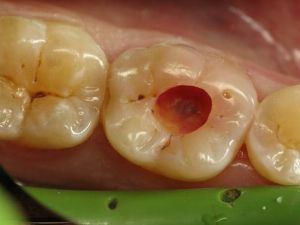 It is difficult to find a man who at least once in his life did not seek help from a dentist because of a hole in his tooth. The resulting hole causes discomfort, pain, and also has a non-aesthetic appearance.
It is difficult to find a man who at least once in his life did not seek help from a dentist because of a hole in his tooth. The resulting hole causes discomfort, pain, and also has a non-aesthetic appearance.
A hole can not be considered a medical diagnosis. This is more a visual description of the problem from the point of view of an ordinary man in the street.
For the dentist, the cavity formed is a signal for prompt treatment of the disease, which has resulted in damage to the dental tissue. The reasons for its occurrence may depend on different circumstances.
The diagnosis is established in each case individually, which determines the type of medical procedures used.
Contents
- Mechanism of formation and development of damage
- What can provoke the formation of a dental canyon?
- Stages of development and symptomatology
- Fast self help
- Emergency measures
- What is advised by grandparents
- Medical methods
- Preventive measures
- Possible complications
Mechanism of formation and development of damage
The hole in the tooth is the result of such a disease as caries. This pathological process is caused by bacteria located in the oral cavity. They feed on carbohydrates and produce an acid that adversely affects the integrity of the tooth.
This results in a small hole in which the bacteria continue to develop. The use of a toothbrush or thread does not make it possible to completely clean the affected area.
Usually, at the initial stage of caries development, a person does not feel any symptoms. In some cases, white or yellowish spots may become noticeable on the tooth.
Over time, the hole increases in size. In the future, sensitivity to sour or sweet foods increases, an inflammatory process develops, which in the end can lead to the need for tooth extraction.
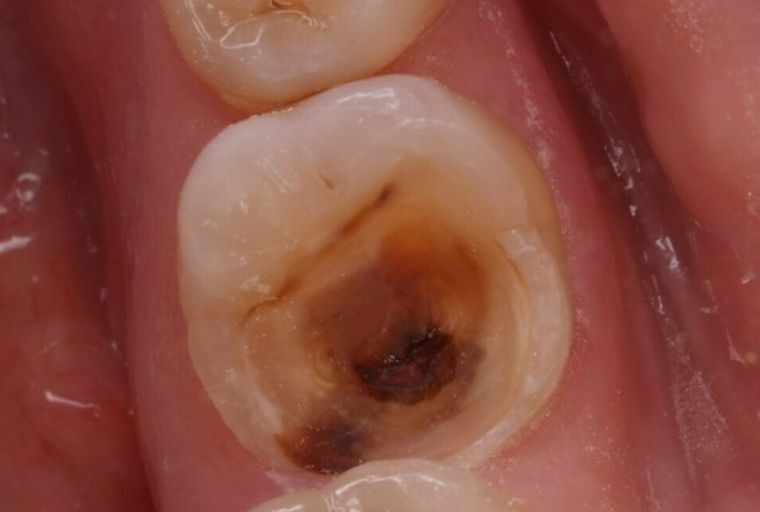
The photo shows a hole in the tooth, as a result of the destructive effect of caries
What can provoke the formation of a tooth gorge?
The medical literature identifies two groups of factors affecting the formation of holes in the teeth:
- lifestyle-dependent ( hygiene, diets, fluoride content in enamel);
- external factors ( heredity, sex, susceptibility to the disease, improper bite, drinking water quality, etc.).
The main prerequisites for the development of caries are:
- Physiology : the distance between the teeth, quality enamel, jaw structure, saliva. With a small distance between the teeth, there are accumulated food particles, creating a favorable microflora for bacteria. The bite affects the degree of enamel wear. Places with the thinnest layer become vulnerable to microorganisms.
- Geography of the .The risk of developing caries largely depends on which country and on which continent the person lives. So, in the USA 99% of residents have problems with teeth. In Russia, this figure is more than 60%, and in Nigeria - only 2%.This is attributed to the peculiarities of climate, the presence of mineral substances in water and soil, terrain relief.
- Power supply .Regular consumption of foods rich in carbohydrates, canned foods, as well as unnatural food additives increases the likelihood of a hollow in the teeth. Stability of the body to the disease can be provided by a diet with the content of vegetables, fruits, a balanced ratio of carbohydrates, fats and proteins.
- Gender .Women complain of caries more often than men. This is due to hormonal changes in the body during pregnancy and lactation. In addition, women are more likely to eat flour and sweets.
Stages of development and symptoms
Depending on the symptoms and signs of the development of the disease, it is customary to distinguish the different stages of caries:
- The initial stage of .On the tooth, small browning is formed. At this stage, the possibility of restoration of tooth enamel. The dentist treats the affected area with a special solution with a high content of calcium, fluoride and minerals.
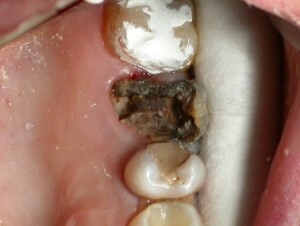 The use of a medical paste or powder is prescribed, a diet is being adjusted( the addition of proteins and products containing calcium).
The use of a medical paste or powder is prescribed, a diet is being adjusted( the addition of proteins and products containing calcium). - Surface caries .It is accompanied by a slight destruction of enamel. Surface has roughness. At this stage, the pain is not felt, but there is a sensitivity to cold or hot food.
- The middle stage of the .It is characterized by damage not only to enamel, but also to dentin. Visually, it can be described as a small hole in the tooth, in which particles of food regularly remain. Discomfort delivers the reception of sour, sweet or salty foods. Often, to relieve pain, even analgesics do not help.
- Deep caries .The cavity increases in size. Damaged enamel, the dentin becomes softened. When touching the bottom of the cavity is painful. Inflammation of the neurovascular tissues( pulpitis) develops.
Fast self help
Depending on the degree of tooth disease, a person can experience both prolonged aching and severe pain with swelling and  with fever.
with fever.
It is obvious that the dentist can only remove the hole in the tooth, and therefore the pain that accompanies it.
However, in the event that there is no possibility to seek medical help, measures should be taken to reduce the pain syndrome and puffiness at home.
Emergency measures
First of all, you need to brush your teeth, thus getting rid of the remnants of food in the mouth. To reduce pain, you need to take analgesics.
They also contribute to the normalization of body temperature. Puffiness can be removed by rinsing the oral cavity with a soda solution. In addition, for 15-20 minutes to the sore spot is applied ice.
What the grandparents of
advise To remove discomfort and reduce pain, people often resort to the use of folk recipes:
- apply propolis, a slice of garlic, a piece of fat or beets to a sick tooth;
- massage the ear from the side where the tooth with the hole is located;
- makes oneself cry, tears help to lower pressure in the jaw area and reduce pain;
It is quite popular to rinse broths from medicinal herbs or alcohol tinctures.
To relieve pain while in nature, plantain can be used. Squeezed juice must be rubbed gums.
Medical methods
Qualitatively stop the process of caries development and carry out professional treatment can only in dentistry.
Any hole in the tooth, regardless of the stage of the disease, is treated according to a similar pattern:
- Treatment of the oral cavity .This can include the removal of plaque or stone on a diseased tooth or hygienic
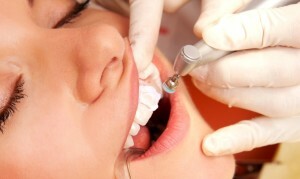 oral procedures in general.
oral procedures in general. - With a significant complication of the disease, medical indications or panic fear of treatment, the doctor makes an injection for analgesia or anesthesia of .
- teeth are removed from the tooth cavity of the tooth .The walls are treated with an antiseptic or boron. This is done to prevent further development of bacteria and relapse of the disease.
- Drilling cavity of the required form , so that the seal in it is retained qualitatively.
- In the deep stage of caries , the treatment pad is applied to the bottom of the tooth. It will have an anti-inflammatory effect on the nerve. Insulating gasket can be used to avoid irritation of the pulp.
- The treated cavity of is filled with filling material, which is the most suitable for the color of the tooth. The inserted seal undergoes bite correction, is polished and polished.
Preventive measures
The main measures to prevent the development of caries, and the accompanying teeth in the teeth are: 
- Oral hygiene .Use paste with fluoride content, rinse mouth after eating, use dental floss or chewing gum.
- Adjusting the diet of .Maximum limit the use of sweet and flour. More in your diet to use foods that are high in phosphorus, calcium and fluoride. Less to drink carbonated drinks.
- A visit to the dentist should be carried out at least twice during the year.
Possible complications of
Untimely access to a medical facility can lead to a caries stage that has started and cause complications in the form of pulpitis or periodontitis.
It is worth considering that in such a situation there is a high probability of using certain surgical manipulations.
The most common complication is pulpitis. This is a process of inflammation of the dental nerve, accompanied by severe pain.
The next more complex stage of the disease is periodontitis. At this stage, not only nerves, but also ligaments that fix the tooth to the bone will be affected.
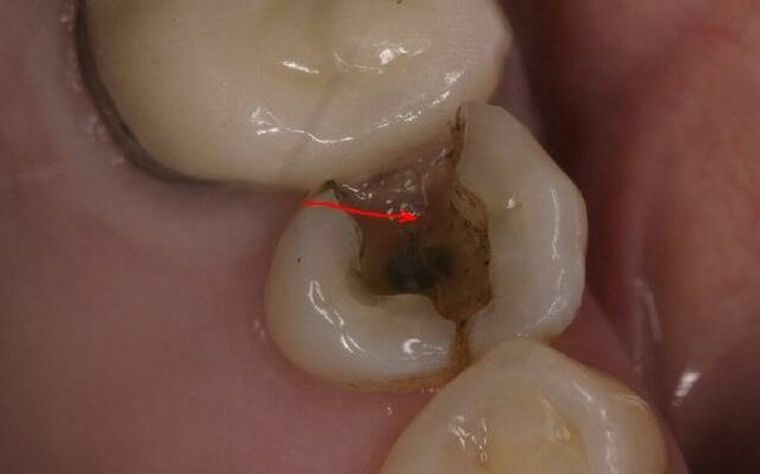
Beginning of pulpitis development
Regular hygiene, absence of bad habits, proper nutrition, as well as modern treatment to the dentist will prevent the formation of holes in the teeth and the complications caused by them.
